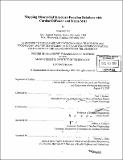Mapping myocardial structure-function relations with cardiac diffusion and strain MRI
Author(s)
Dou, Jiangang, 1972-
DownloadFull printable version (5.854Mb)
Other Contributors
Massachusetts Institute of Technology. Dept. of Nuclear Engineering.
Advisor
Van J. Wedeen.
Terms of use
Metadata
Show full item recordAbstract
The myocardial structure-function relation is the key to understand the functional design of the ventricular myocardium. While the function of myocardial fibers has been extensively studied, the recently observed laminar organization (sheets) of myocardial fibers is not well understood. This thesis establishes noninvasive MRI methods, registered cardiac diffusion and strain MRI, to acquire information about myocardial sheet structure and myocardial strain under identical in vivo conditions, and thus defines the functional role of myocardial sheets. This methodology solves limitations of existing methods that require postmortem dissection, and can be applied to living humans at multiple time horizons in the cardiac cycle. To establish valid MRI methods to map myocardial structure, we present a new method for diffusion MRI in the beating heart that is insensitive to cardiac motion and strain. Using phantom and in vivo validations, we demonstrate that this method addresses the problem of motion sensitivity of diffusion MRI in the beating heart. We also map myocardial sheet and fiber structure during systole in normal humans and find evidence that sheet architecture undergoes remarkable changes during contraction. To establish valid MR methods to quantify myocardial strain, we present a new 3D phase contrast strain imaging using single-shot 3D EPI. Compared to previous phase contrast 3D strain methods, the new method realizes potential sensitivity of phase contrast EPI. It significantly improves image quality regarding noise and artifact, requires much shorter acquisition time, and can be quickly and automatically processed without operator supervision. Following validation using a strain phantom, (cont.) we demonstrate the validity of our 3D single-shot strain method in healthy in vivo human heart and brain. Using these methods, we acquire registered diffusion and strain MRI to provide quantitative maps of myocardial structure-function relations in living humans. From these quantitative maps, we are able to define for the first time accurate images of the functional role of myocardial sheets. We find that myocardial sheets contribute to ventricular thickening through all three cross-fiber strain components: sheet shear, sheet extension, and by previously undocumented sheet-normal thickening. Each of these mechanisms demonstrates remarkable spatial non-uniformity as well as inter-subject variability. In all cases, the contributions to thickening of fiber strains are small. Sheet function in normal humans is found to be heterogeneous and variable, contrasting with the previously demonstrated uniformity of fiber shortening. Future studies on myocardial structure-function relations must investigate the causes and extent of such heterogeneous properties of the myocardium. This thesis shows that MRI is a valid and effective tool for noninvasive study of myocardial mechanical function in humans.
Description
Thesis (Ph. D.)--Massachusetts Institute of Technology, Dept. of Nuclear Engineering, 2002. Includes bibliographical references (leaves 107-115).
Date issued
2002Department
Massachusetts Institute of Technology. Department of Nuclear Engineering; Massachusetts Institute of Technology. Department of Nuclear Science and EngineeringPublisher
Massachusetts Institute of Technology
Keywords
Nuclear Engineering.